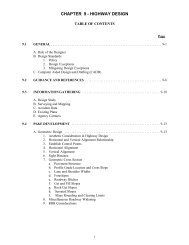Baltimore-Washington Parkway Widening Feasibility Study
Baltimore-Washington Parkway Widening Feasibility Study
Baltimore-Washington Parkway Widening Feasibility Study
- No tags were found...
Create successful ePaper yourself
Turn your PDF publications into a flip-book with our unique Google optimized e-Paper software.
<strong>Baltimore</strong>-<strong>Washington</strong> <strong>Parkway</strong> <strong>Widening</strong> <strong>Feasibility</strong> <strong>Study</strong>Public Involvement4.0PublicInvolvement4.1OverviewoftheContext-SensitiveSolutions(CSS)Approachtothe<strong>Feasibility</strong><strong>Study</strong>As is often the case with major infrastructure projects, the original planning and construction of theexisting B-W <strong>Parkway</strong> created great anxieties in several of the communities along the corridor.Ultimately, the B-W <strong>Parkway</strong> divided several neighborhoods that still harbor that anxiety today.It is clear that any study investigating the feasibility of widening such a symbolic corridor needs toassess not only environmental, economical, and engineering feasibility, but also the feasibility ofcommunity, and ultimately, political acceptance. Given the contentious history involving the B-W<strong>Parkway</strong>, it would be impossible to fully and fairly assess the feasibility of widening the facility withoutfully engaging the community and providing the opportunity to create and evaluate contextuallysensitive alternatives. With this in mind, a CSS approach to public involvement was implemented. TheCSS process is a strategy that seeks proactive engagement of project stakeholders in the identification ofthe issues and priorities related to a proposed project that informs the evaluation of analysis andoptions. This meant approaching communities with an open mind, listening, and continually gainingfeedback as the work leads to more plausible outcomes for the study.The CSS public involvement approach was multipronged, including community residents and employeesin the corridor, business and political leaders, and representatives of various governmental agencies.The residents and employees were reached through newsletters and involved in public meetings.Business and political leaders were reached through a set of stakeholder interviews, and local, State,and Federal Governmental agencies comprised a Technical Advisory Committee.4.2TechnicalAdvisoryCommittee(TAC)The TAC was comprised of the Federal agency partners, local and State agency officials and othergovernmental partners representing the predominant interests in the B-W <strong>Parkway</strong> corridor. The threemeetings they attended served as forums for discussions of the issues surrounding the corridor andstrategies for addressing them through the study options. They also served as sounding boards formaterials to be presented to, and inputs received from, the public meetings, and advised on the publicpresentations to ensure the material was easily understandable to the public. A total of three sessionswere spent presenting to and receiving very valuable and insightful advice from the TAC.4.2.1TACMemberAgenciesThe TAC included the following agencies:AmtrakAnne Arundel County Office of Planning and Zoning<strong>Baltimore</strong> County Office of Planning<strong>Baltimore</strong> Metropolitan Council's <strong>Baltimore</strong> Regional Transportation Board37 November 2012
















